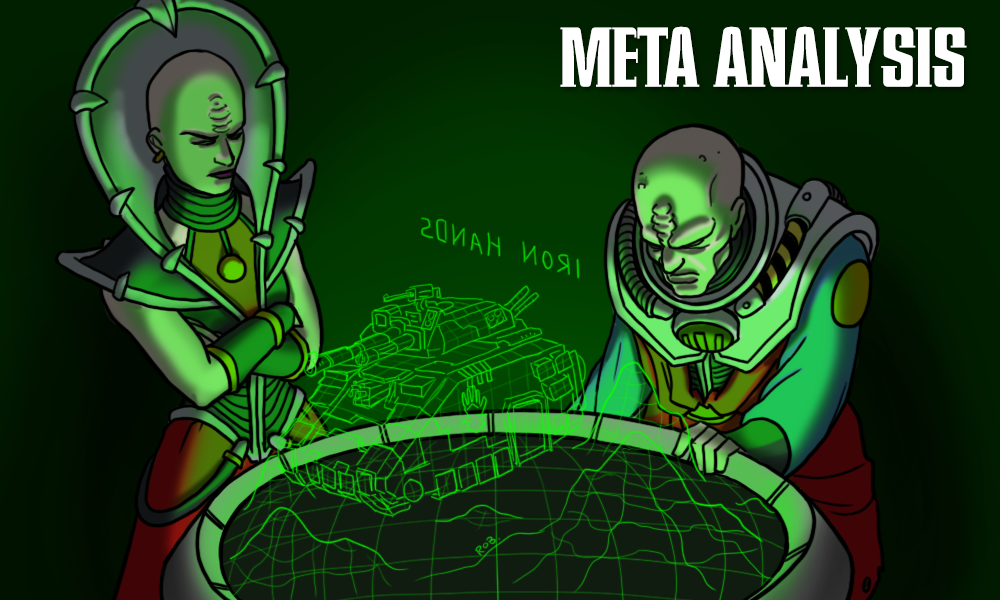Well, I did say it would be back if something interesting happened! While pretty much the entire rest of the world has been plunged into a renewed lockdown, Australia and New Zealand have been able to just keep trucking along (thanks to having the virus largely handled) and this past weekend saw the first run of a new regular team event series in Australia, put on by Gladiator Gaming. A loyal reader has brought this to our attention, and while the focus of this column is normally on singles events, this quieter period is the perfect time to take a look at something a little different. While strong singles lists will still perform well in team events, the format introduces some unique incentives for a team looking to maximise their score, which can really help bring out some more unusual or extreme armies. With the advent of the new World Team Championship that is (hopefully) going to go ahead next year, there’s also growing interest in team formats in general.
With all that in mind, for today’s special edition of Competitive Innovations, we’ll quickly break down how the format at this event worked, what incentives that creates for team construction, and then look at the rosters put up by the top two teams to see how that got put into practice.
All the lists for the event can be found in Down Under Pairings here. As ever as a last thing before we start, if you have any event tips you’d like to send in please do hit me up at contact@goonhammer.com (and yes I’m aware that there’s a reasonably large four-round Aussie event this weekend, and I’ll probably cover it).
Tournament Format
When we talk about “Team Events”, what we’re usually referring to is an event where rather than players just matchup up in a swiss fashion, whole teams (which can have a varying number of players depending on the event) get lined up, and the players within the teams get paired up for that game using some form of non-random decision process that the teams have agency in. In general, each game is scored on some sort of differential points system, and the winning team from the matchup is the one that accumulates more points. Finally, there are often limitations on how often a certain codex can show up in each team’s set of lists, meaning you usually see a more diverse field as teams dig beyond tier one to find their armies.
The Gladiator Gaming event had four player teams, and versions of all of the above in place. You can see the full details in their event pack, but I’ve broken the key details down here.
Army Choice
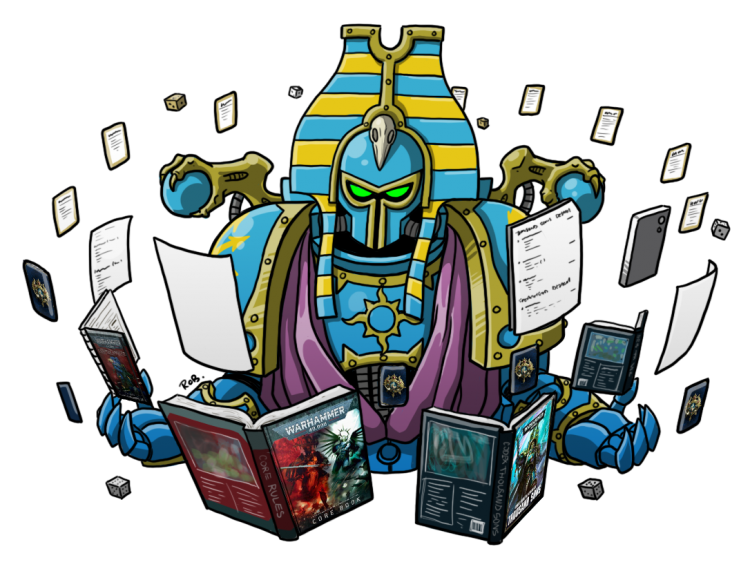
How It Worked
The event followed a fairly standard setup for army choice at team events – each Codex can only be used once per team. Beyond that, standard army construction rules applied, with the only difference from standard singles play being that no Forge World models with PL30+ were allowed.
What it Means
In a world where all loyalist Space Marines are now operating from a single codex, this definitely forces players to cast a bit wider for their army choices. Luckily, 9th has a pretty healthy spread of powerful factions, and there are more than enough armies in tiers 1 and 2 for teams to pick from, especially since other aspects of the format favour more skewed lists as we’ll see. It does mean that not every list you field has to have a plan against Space Marines, which I imagine is a blessed relief for some players.
Scoring
How It Worked
Each game within each match was scored on a “20-0” system, meaning that the winner of each game scores between 11-20 pts for their team’s total, while the loser gets 0-9, depending on the margin of victory. In 8th Edition this generally scaled for every 2pts of VP margin (rounded up), so winning the game by 19+VP got you the maximum 20pts (some events also shunted the margin up by 2VP, and made any margin smaller than that a draw).
9th Edition’s scoring gives players much larger points totals, so in line with what other team events have done, Gladiator have scaled the margin to tick up at every 5VP difference, and were using draws for scores smaller than that. This meant that a player needed to end the game with 6+ VP more than their opponent to get a “win” at 11-9, and a massive 51VP+ to score the full 20pts.
What it Means
In a singles event, your goal is to win every game, and the margin doesn’t usually matter (though a high absolute VP score for yourself does help with tiebreaks). With 20-0 scoring, two new incentives are introduced:
- You want to achieve crushing victories where possible, racking up more points for your team.
- Being able to force through some points even when you lose still helps your team towards a win.
9th Edition games absolutely do end with 51VP+ margins relatively frequently, but the nature of the scoring means that it’s quite hard to consistently force that against an opponent that is willing to sacrifice a chance of winning to ensure they at least don’t lost that badly, and as we’ll see that’s definitely a plan you can build for. It also puts extra pressure on to run lists that don’t easily give up maximum points on any of the kill secondaries, as giving your opponent 15VP on the way to victory seriously impairs your chances of a big win.
By itself this would have some impacts, but the reason it really starts to matter is because of how matchups are decided.
Pairings
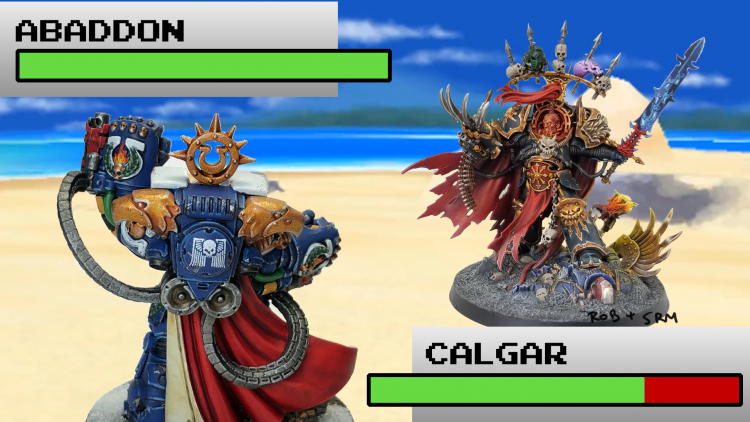
How It Worked
Here I’m just going to copy from the pack verbatim. Once teams have been paired up, within each matchup the following process was followed to assign player pairings.
- Both captains select one list secretly to be their champion and place it to one side
- Both captains roll a dice
- The lowest rolling captain (captain B) puts forward a list
- The Higher rolling captain (captain A) matches a list against the list put forward, with captain B picking the table they will play on.
- Captain A then puts a list forward
- Captain B then matches a list against this with captain A choosing the table
- The two unmatched players play on a table chosen by captain B
- The champion lists are matched and play on the last table
While most singles events standardise the terrain across all tables, most team events don’t in order to make the table choice aspect more meaningful. I don’t know for sure how the tables were set up here, but for a four table event it would be reasonably common to have one densely packed table, two with terrain roughly at the level of a normal singles event, and one lighter.
What it Means
In real terms, that means each round one of the following two things happens:
Either:
- You put forward one list that could come up against anything on unknown terrain. You may want this to be a strong all-comers list.
- You put forward one army that your opponent can match up with (as far as you know) any of their lists, but you get to choose the terrain. There are a few ways you can go with this, but your goal is to ensure you still get as many points as possible out of what is likely to be a favourable matchup for your opponent.
- Your opponent has to put forward one of their remaining lists which you get to pick a matchup for from your remaining two, but they get to pick the terrain. You want to have access to good counterpicks at this stage.
- Your last list also ends up fighting on unknown terrain. That means you ideally want any list in your setup that’s likely to be left till last to be able to adapt to, or at least make a decent showing, on any table.
Or:
- You put forward one list that could come up against anything on unknown terrain. As above, a strong all-comers list will help.
- Your opponent puts forward one army, and you can pick whichever of your three remaining lists you think can best counter it on your opponent’s choice of terrain. While you get a lot of choice here, it’s likely that your opponent will select an army that’s either very good at ensuring a modest score or has a strong plan for the terrain, so you need to be able to crack them.
- You put forward a list that your opponent could (theoretically) have any of your opponent’s three remaining lists sprung on it, but you get to pick the terrain. That means you still ideally want a list that can “defend” scoring effectively, but here trade off your opponent having a narrower set of choices with there being one fewer table to choose from.
- Your last list also ends up fighting on unknown terrain.
Pairings in team events are an art form in themselves, and the outline above is really only scratching the surface of what you can do. Still, examples can help, and following the outline above this is where I’d aim my first stab at a rough team composition to try and play to this setup as follows:
- One top tier singles list for the champion slot, preferably one that has few terrible matchups and can operate with any level of terrain. Sisters of Battle, Harlequins, White Scars and some Daemon lists would all fit this bill.
- One “defender” list to throw out in the slots where the opponent gets a broad counterpick, especially if my team loses the rolloff. This could either be a list with a very strong plan to play the primary that’s hard to disrupt, ensuring that any loss is likely to be moderate rather than a full 20-0, or one that’s extremely good at operating on certain kinds of terrain. These we’ll talk about when we look at the teams.
- Two lists designed to be used as counterpicks, both of which at least have a plan in an all-comers game. These should be lists that are either extremely effective counters to some other armies or demand very specific answers from an opponent to beat. Lists at either the extreme end of horde builds or highly elite setups that don’t bleed secondaries can both fit into this slot effectively, and either mobility or melee capability would be a plus, as they could end up fighting on any level of terrain. The goal with these is to try and ensure that in the matchup where you get to counterpick, you walk away with a high score.
This is far from the only way you can go, of course. You could decide to skew all of your lists in once direction and bet on your opponents not having enough counters, you could bring multiple “defender” lists to play for draws and rely on one perfect counterpick to score your big points, and plenty more options besides. There’s huge depth to any such systems, and I’m reliably informed that this is why team event players love them quite so much. Things also only get wilder once you expand the team sizes out (as the World Team Championship does) and is a major reason why team events often contain lists that look baffling to players who only participate in singles.
Team List Analysis
I am, it should be stressed, primarily a singles player, so I’m definitely looking at this from the outside in, but with that said what we’re going to do for the rest of the article is look at each of the top two teams from the Gladiator Games event and break down their full composition rather than each list in turn. The goal is to work out not just why each list functions, but what role it has to play in the context of the overall team and the pairing system.
10 teams participated in the event, but once the dust settled two sat atop the pairings, which were checks notes uh, “Art of War Team 1” and “Art of War Team 2”. Looks like Art of War Down Under are keen to keep standards up!
Art of War Team 1 – 1st Place
The Lists
Erik Lathouras’ Sisters of Battle
Army List - Click to Expand
Aron Green’s Orks
Army List - Click to Expand
James Keller’s Necrons
Army List - Click to Expand
Steven Wade’s White Scars
Army List - Click to Expand
The Breakdown
Now obviously, just because team event lists sometimes go to unusual places doesn’t mean they don’t go hard and none of the lists above are things that I would exactly want to play against round one at a singles event, but for regular readers familiar with what we’ve been seeing in top lists from these factions it’s clear that there are some significant differences from their normal compositions, so let’s take a look at them through the lens of the pairing system and see if we can assign them roles.
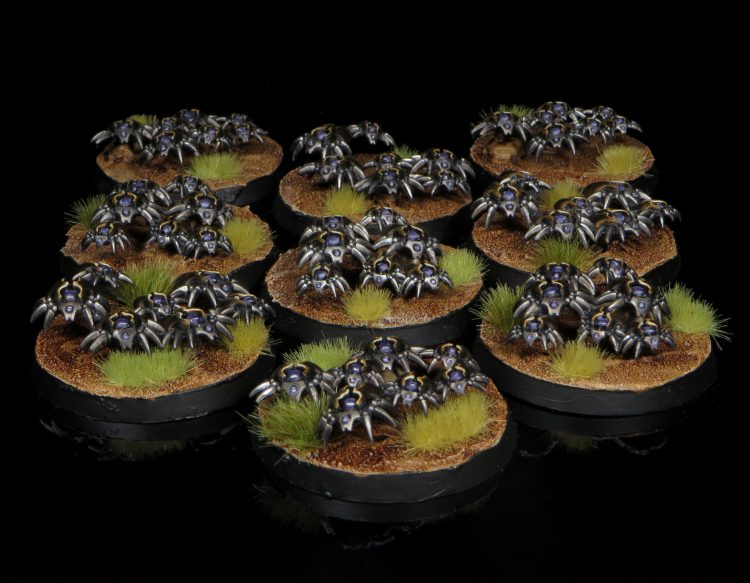
We’ll start off with the Necron list, which here I would squarely flag as a “defender” army. The Eternal Expansionists plan is a very good one for this role, as it operates by pushing large numbers of ObSec models onto lots of objectives right out of the gate, minimising the opponent’s early scoring and ensuring that these armies tend to reliably build a primary lead out of the gate. They also don’t tend to field much that’s vulnerable to kill secondaries, and have enough fast units to reliably score board control based ones themselves. While this is proving a popular strategy in singles play as well, the reason I’ve pegged this list in particular as a defender build is that it tweaks some of the standard components to fully lean in to ensuring the “floor” of points it achieves is quite high. The Silent King tends to be a fixture of these builds, providing a hammer unit that can also draw firepower away from some of the ObSec components. However, when on the Defender plan he’d plausibly be a liability – your opponent would have free reign to pick an army that can pop him off the board out of the gate, potentially taking 13pts for Cut off the Head and ruining any point denial plan. Sure you could strat reserve him, or maybe hide him if you picked a dense board, but it introduces a failure case in the defender plan.
Instead, the list sports a full block of shield Lychguard and a second unit of Skorpekh Destroyers compared to more normal builds, providing another very tough to shift objective holder and a hammer unit that can exploit terrain to constrain where the opponent can safely go until they’ve done their thing, delaying the point where the opponent gets to flip the scoring and build up any sort of lead. I went and had a look at the results to try and work out if I was on the ball with this, and sure enough the first two games this army played ended up as narrow losses (the third was a win in the mirror). Paradoxically in team events, a string of narrow losses is often a sign of some of the best play, as it can represent a player being repeatedly thrown onto the teeth of tough matchups and still eking out points.
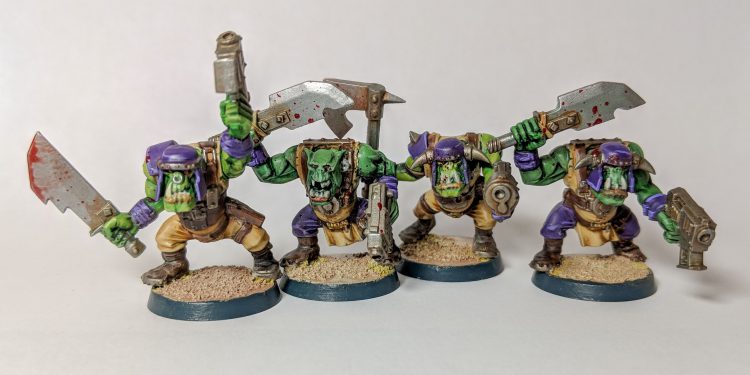
That leaves us with three left to categorise, and the one that’s easy to peg is the Ork list. 150 Skarboyz is one of the easier examples of a counterpick/difficult question list – many armies flatly cannot deal with that number of models and will get overwhelmed and be unable to realistically contest the primary. When that happens, this list is going to win big, and sure enough, Aron got the maximum 20-0 score in all three of his games, helping to power the team to their victory. As a bonus, a horde list this extreme can plausibly slot into the defender or champion role in some team matchups, as if the opposing team has nothing that can answer it then it neutralises a favourable pick window.
With two armies left, we’re theoretically looking for one all-comers champion build and another counterpick build. Neither looks exactly like standard setups for their factions, but for my money I’d say the Sisters list is the more likely champion army. It’s a bit closer to builds we’ve seen do well at singles events (such as Shane’s from the YHP Fall Brawl) and stands out compared to the White Scars list as having very few truly terrible matchups. It skews a bit more hordey and a bit less deadly than singles builds, but ultimately has a similar overall plan of overwhelming the enemy with 4++ bodies that can fight in melee, and makes sure to pack enough ObSec to counter anyone trying the Eternal Expansionists plan. By going as wide as it does when the team already has two other high wound count lists, it also adds up to a team-level skew that might overwhelm the number of viable counter lists opposing teams have to bring to bear.
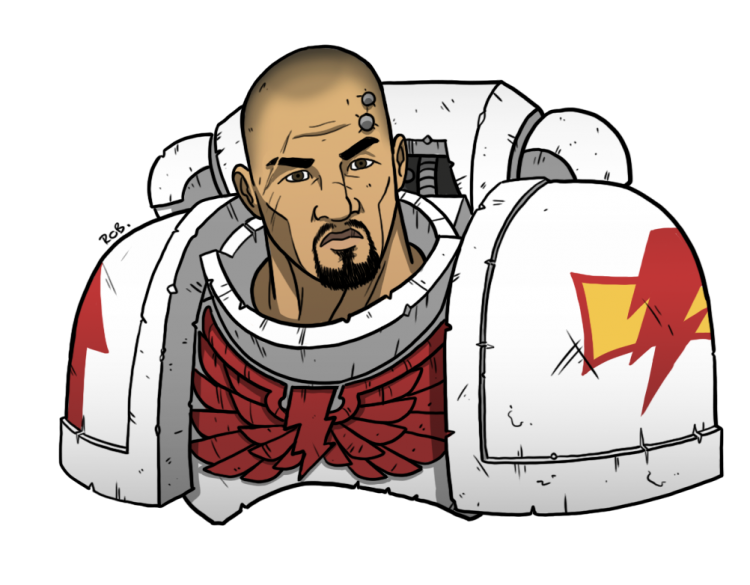
That leaves us with the White Scars, and while you could definitely play this as an all-comers build, it’s short on the Infiltrators and Incursors that would convince me that was the plan. Instead I think this is mostly here as the second counterpick, and here what it’s aiming to do is answer matchups where you need to shift a large number of multi-wound models in a hurry. The damage output on this list is incredibly stupid, and it’s attached to a whole bunch of very mobile models that can get into position at speed, especially with all of the mobility tools that White Scars have access to. This makes it the perfect counter to something like this very team’s Necron list, whose goal is to make a nuisance of themselves for like the better part of four turns. This list has a very real chance of evaporating that entire army in two or three, especially if it goes second, and would also be a strong counter to something like a Beast of Nurgle heavy build. The reason you probably wouldn’t run exactly this in singles is that it’s highly vulnerable to lists that can launch a strong counterattack, as it doesn’t put that many bodies on the board and most lack invulns. Harlequins would cause this army a big headache (especially the builds with Hornet backup) as they can easily outrange the shooting out the gate then swoop in and delete like a third to half of it in a turn. There aren’t that many lists fitting that exact descriptor of course, so there would still be matches where you could play it by ear and use this in a more all-rounder slot, but it’s a good demonstration of how team play changes things up.
In fact, in general, I couldn’t have asked for a nicer first set of lists to demonstrate the overall structure here. Congratulations to the team, and now lets move on to our second example to see some other dynamics in action.
Art of War Team 2 – 2nd Place
The Lists
Dan Savage’s Chaos Daemons
Army List - Click to Expand
Andrew Kennedy’s Adeptus Mechanicus
Army List - Click to Expand
Joshua McGowan’s Necrons
Army List - Click to Expand
Paul Gurney’s Iron Hands
Army List - Click to Expand
The Breakdown
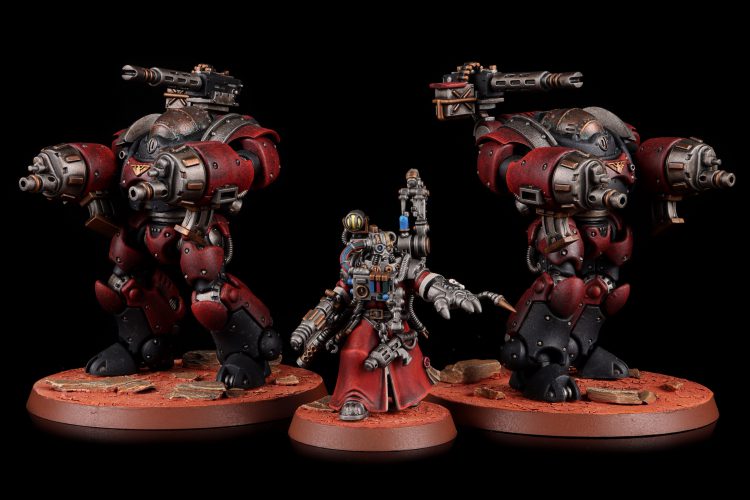
Credit: Pendulin
So, here’s the fun thing with team events – sometimes you see a list that looks so utterly prepostorous to normal sensibilities that you do a double take, and that’s very much what the AdMech build here achieves. When you see something like that, you have to step back and consider how the format incentivises here, and my guess is that what we’re seeing here is the second major type of “defender” list – one that is so horrific to play against on its favoured terrain that even armies that would normally be a counterpick are given real pause. 8 Kastellan Robots on light terrain with the Lucius Canticle up is a total screaming nightmare to consider trying to take on with pretty much any kind of offence. They have the weight of fire to delete an Ork horde, are near impregnable to ranged firepower for at least a turn, and are backed up by some Serberys Raiders to ensure an opponent that doesn’t move within their sightlines will lose the primary, and Skorpii to pick off stragglers hiding behind whatever terrain there is on a light board. Would you play this list on a double-L configuration or singles event where you didn’t know the tables? Absolutely not, but if you can chuck it onto a light table every time, you’re going to have a good time of it. As an added bonus, I think it’s conceivable that (assuming there was a “light” table) this list is so skewing that if your opponents have to put up the first defender they’re probably obliged to choose the light table just to stop you having it, which is often a downside for the point-denial flavour of defender lists.

While there’s a clear defender/skew pick in the AdMech, the rest of these lists aren’t quite as clearly sorted into roles. Neither the Iron Hands nor Daemon list would look at all out of place in a singles event, both packing a whole bunch of their quality tools. There are still some ways in which the team setup affects the builds, however. The Iron Hands list is adapted for more of a close quarters engagement than we’re used to seeing from the faction, packing a large Terminator unit, some Assault Centurions and having some of its shooting on mobile platforms. This makes sense when you consider that this team is always aiming to get the AdMech list onto the least dense terrain it can manage, meaning it has to anticipate that its other builds are a bit more likely to end up on heavier terrain. The Daemons list, meanwhile, packs some Bloodletters to try and hedge against one of the ways in which it could plausibly get countered (i.e. being overwhelmed with ObSec models). Bringing an extra hammer unit with ObSec can help it to flip an objective on a key turn, helping mitigate that angle of counterplay and, again, helping if the army ends up on a heavier table where the Greater Daemons are struggling to manoeuvre.
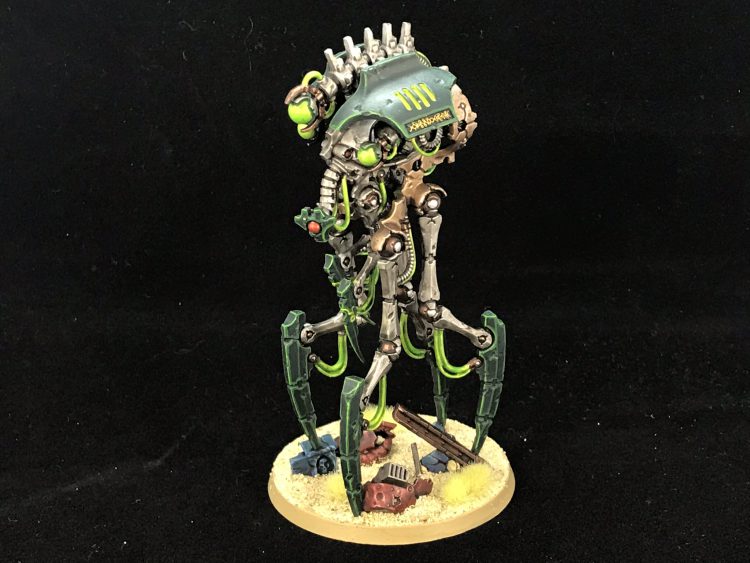
Finally, we have a very different spin on the Eternal Expansionists Necron list, still featuring the always popular Scarab Swarms, but taking two blocks of Necron Warriors instead of the more normal Wraiths to fill out, and even squeezing in two of the much-maligned Canoptek Reanimator to try and keep them alive. On paper this feels like a slightly weaker iteration of the army than the version from team 1 but we need to consider it in light of the fact that this team already has an army to use as their defender pick a lot of the time. My suspicion is that the aim with this list is to throw it at opposing defender lists that are on the same plan, and out-do them by managing to put more ObSec models onto mid table objectives.
The normal drawback of Reanimators is that they die to a stiff breeze against ranged firepower, but if you’re confident that what you’re going to mostly be up against are other durable lists with low to medium output (or melee only builds) they’re suddenly much more attractive, helping keep the army on the objectives for longer. With that durability focus, this list can also become a “backup” defender list for the team in the unlikely event that their opponents do have something that can outright counter the Kastelans somehow. From looking at the scores, I don’t think this worked out quite as well as the other Necron build did overall, but seeing the Reanimator actually put to use really does highlight how strange a world team events are. The other thing to note with this list is that thanks to the price of the Cryptek Arcana the three characters become the targets under While We Stand We Fight, providing another source of points that can be challenging to deny in a mirror match. This was available to the other build as well, but this list has slightly more things it can use to keep them safe, and it seems to have come up more often as a strategy based on the scores.
Overall, this team does seem to have ended up on a slightly different plan than the previous one, with two lists that can genuinely play the all rounder game and two lists that sort of fit into a defender role, with less out and out counter builds. Given they were only pipped to first place by being held to a draw in round two, it’s a good demonstration that even at small team sizes, there are multiple ways you can go.
Wrap Up
Hopefully you’ve enjoyed our first look at a team event, and do let us know either in the comments or at contact@goonhammer.com if you’d like to see more, as Gladiator Gaming is planning on running these every two months going forward, so there will be ample further opportunities to cover them in the future. Other than that, stay safe and we’ll be back with a lite edition next week covering other goings on down under.
